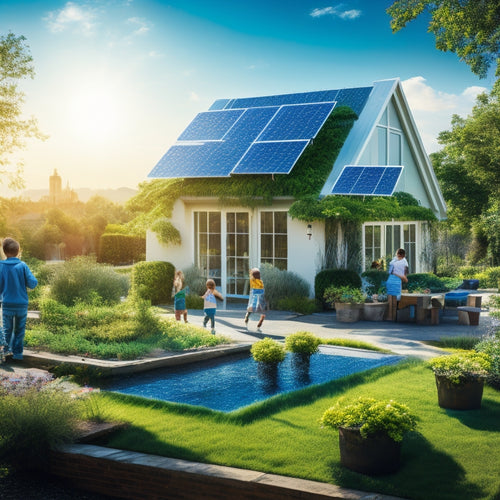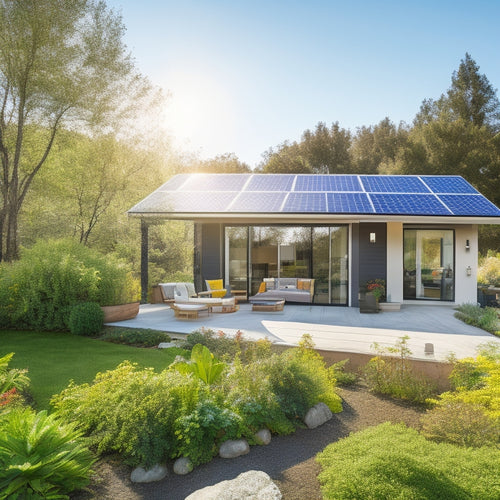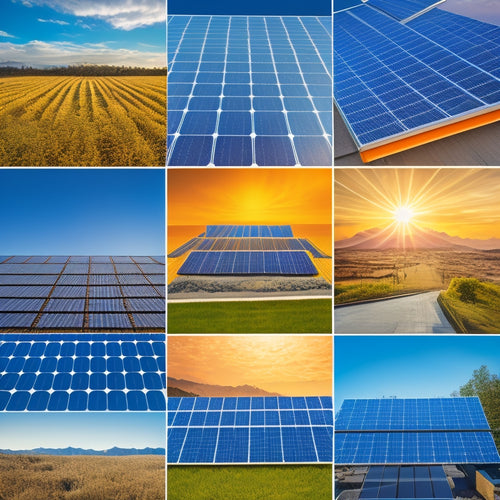
Setting Up Solar Power for Your House in 10 Steps
Share
To set up solar power for your house, start by evaluating your energy needs to determine the right system size. Then, check local solar policies and permitting requirements to guarantee compliance. Next, determine your budget and investigate financing options. Choose a suitable solar panel type, and select a reputable installer. After that, install mounting and tracking, connect to the grid, and monitor and maintain the system. Finally, inspect and test the system to verify peak performance. By following these steps, you'll be well on your way to utilizing the power of the sun - and soon, you'll be reaping the full benefits of your solar investment.
Key Takeaways
- Assess your energy needs by reviewing past utility bills and identifying energy-intensive habits to determine the required solar system size and complexity.
- Determine your budget by estimating total installation costs, including panels, inverters, and labor, and exploring financing options like loans and power purchase agreements.
- Choose a reputable solar panel installer by verifying their credentials, checking online reviews, and inquiring about installation timelines and warranty options.
- Ensure a smooth installation process by conducting a roof structure assessment, performing a shading analysis, and confirming installation accessibility.
- Monitor and maintain your solar power system by investing in monitoring technology, performing routine inspections, and troubleshooting issues promptly.
Assess Your Energy Needs
Your energy usage patterns play an essential role in determining the size and complexity of your solar power system. To accurately assess your energy needs, you'll need to examine your energy consumption and lifestyle habits.
Start by reviewing your past utility bills to identify your average daily energy usage in kilowatt-hours (kWh). Consider the number of occupants in your household, their daily routines, and the types of appliances and devices they use. For instance, if you have family members who work from home or have multiple teenagers, your energy consumption may be higher due to increased usage of computers, lights, and refrigerators.
You should also consider your energy-intensive habits, such as using electric water heaters, pool pumps, or electric vehicle charging stations. Additionally, think about your energy-saving habits, like using energy-efficient light bulbs or turning off appliances when not in use.
Check Local Solar Policies
You'll need to research the local solar policies that apply to your area, including the solar incentives available to you and the permitting requirements you must meet.
These policies can greatly impact the cost and feasibility of your solar power system.
Solar Incentives Available
The homeowner's decision to invest in solar power can be greatly influenced by the availability of incentives, which vary by location.
You'll want to research and understand the incentives available in your area to maximize your savings.
At the federal level, you're eligible for tax credits, which can greatly reduce your upfront costs. Additionally, many states offer rebates or credits for solar installations.
You should also examine solar financing options, such as loans or power purchase agreements, which can help make solar more affordable.
Net metering policies allow you to generate your own electricity and export any excess to the grid, offsetting your energy consumption.
Community solar programs enable you to invest in a shared solar array, ideal for those with limited roof space.
When comparing solar incentives, consider renewable energy certificates, which represent the environmental attributes of one megawatt-hour of renewable energy.
Finally, look into energy efficiency programs, which may offer additional incentives for energy-saving upgrades.
Local Permitting Requirements
Before installing solar panels, homeowners must maneuver local permitting requirements, which vary by jurisdiction.
You'll need to familiarize yourself with local regulations that govern solar panel installations. The application process typically involves submitting plans and specifications for your solar panel system, which must meet necessary permits and zoning laws.
You'll need to obtain necessary permits from your local government, which may include electrical, building, and zoning permits.
Additionally, you may need to comply with inspection requirements, which guarantee your system meets safety and performance standards.
It's also essential to provide utility notifications, as your solar panel system will be interconnected with the grid.
In some cases, environmental assessments may be required, particularly if your installation is located in a sensitive ecosystem.
Finally, be sure to follow installation guidelines, which outline the specific requirements for installing solar panels in your area.
Determine Your Budget
You'll need to determine how much you're willing to invest in a solar power system, so estimate the cost of solar panels and other equipment based on your energy needs and the size of the system you require.
Additionally, calculate the energy savings potential of a solar power system to understand the long-term financial benefits.
Solar Panel Cost Estimate
Estimating the cost of solar panels is essential in determining your budget, as it directly affects the feasibility of your solar power project. You need to evaluate the total installation costs, including the cost of the solar panels, inverters, mounting hardware, and labor.
The average cost of solar panels ranges from $2.50 to $3.50 per watt, depending on the quality and efficiency of the panels. For a typical residential solar power system, the total installation cost can range from $15,000 to $30,000 or more.
You'll also need to examine solar financing options, such as loans, leases, or power purchase agreements. These options can help you spread the upfront cost over time, making solar power more affordable.
Additionally, you may be eligible for federal and state tax incentives, which can help offset the cost of the system. By understanding the total cost of ownership and exploring available financing options, you can create a budget that works for you and make your solar power project a reality.
Energy Savings Potential
Your energy savings potential plays a critical role in determining your budget for a solar power system. It's crucial to assess your current energy consumption and identify areas where you can improve energy efficiency. By doing so, you'll be able to determine the size of the solar power system you need, which directly impacts your budget.
When evaluating your energy savings potential, consider the long-term benefits of solar power. Not only will you reduce your reliance on the grid, but you'll also decrease your environmental impact and contribute to a more sustainable living environment.
With renewable resources like solar power, you'll enjoy cost reduction and energy independence. Additionally, you'll be taking a significant step towards grid independence, which is becoming increasingly important as the world shifts towards cleaner energy sources.
To accurately determine your energy savings potential, you'll need to analyze your past energy bills and identify opportunities for improvement. This will help you create a realistic budget for your solar power system and make certain that you're getting the most out of your investment.
Choose a Solar Panel Type
As you commence on the expedition to harness solar power for your house, selecting the right solar panel type is an essential step.
You'll need to take into account factors such as efficiency, durability, and aesthetics to guarantee you're getting the most out of your solar investment.
When choosing a solar panel type, take into account the following:
- Monocrystalline panels: These high-efficiency panels offer superior performance and durability, but come at a higher cost.
- Polycrystalline panels: A more affordable option with slightly lower efficiency ratings, but still reliable and durable.
- Thin film technology: A budget-friendly option with lower efficiency ratings, but ideal for large-scale installations or non-traditional roofing materials.
Beyond panel type, evaluate solar efficiency ratings, panel warranties, and installation orientation to maximize energy production.
Additionally, assess temperature coefficient, inverter types, and solar aesthetics to guarantee your system meets your energy needs and complements your home's design.
Select a Reputable Installer
Reliability is the cornerstone of a successful solar power system, and it starts with a reputable installer. You want to verify the installer you choose has the necessary credentials, such as certifications from organizations like the North American Board of Certified Energy Practitioners (NABCEP).
Check online customer reviews to get a sense of the installer's reputation and level of customer satisfaction.
Ask potential installers about their installation timeline and warranty options. A reputable installer will provide a clear timeline for the installation process and offer extensive warranties that cover the system's performance and equipment.
Additionally, inquire about service agreements and post-installation support. A good installer will offer regular maintenance and monitoring to confirm your system operates at peak energy efficiency.
Prepare Your Roof Structure
Prepare Your Roof Structure
Most residential roofs can accommodate a solar power system, but it's essential to assess your roof's structure before installation. A thorough roof inspection will guarantee your roof can support the weight and stress of solar panels.
You'll want to evaluate the structural integrity of your roof, considering factors like roof orientation, materials durability, and weather considerations.
Conduct a shading analysis to identify any obstructions that might affect your system's performance. This includes trees, buildings, and other features that could cast shade on your roof.
To prepare your roof, consider the following:
-
Installation accessibility: Confirm your roof is easily accessible to facilitate a smooth installation process.
-
Future renovations: Think about any upcoming renovations or changes to your roof that might impact your solar power system.
-
Weather considerations: Assess your roof's ability to withstand various weather conditions, such as high winds, heavy snowfall, or extreme temperatures.
Install Mounting and Tracking
With your roof structure assessed and prepared, you're ready to move on to the installation of the solar power system.
Now, it's time to install the mounting and tracking components. You have various mounting options to choose from, including roof-ground mounts, flush mounts, and ballasted mounts. Each option has its advantages and disadvantages, so select the one that best suits your roof type and solar panel configuration.
Next, you'll need to decide on a tracking system. Tracking systems optimize energy production by adjusting the solar panels' angle and orientation to follow the sun's movement. You can choose from single-axis or dual-axis tracking systems, depending on your energy requirements and budget.
Confirm that your chosen tracking system is compatible with your mounting option and solar panel configuration.
Proper installation of the mounting and tracking components is essential to maximize energy production and guarantee the system's longevity.
Take your time to carefully plan and execute this step, and consider consulting with a professional if you're not confident in your abilities.
Connect to the Grid System
Now that your mounting and tracking components are securely in place, you're ready to connect your solar power system to the grid. This critical step enables you to feed excess energy back into the grid and offset your energy consumption during periods of low solar production.
To complete the grid connection, follow these essential steps:
-
Install a grid tie inverter: This device converts the DC power generated by your solar panels into AC power that's compatible with the grid.
-
Connect to the main service panel: Guarantee a safe and efficient connection by linking the inverter to your main service panel, which distributes power throughout your home.
-
Configure energy management settings: Program your system to optimize energy production and consumption, considering factors like time-of-use rates, energy storage, and grid demand response.
With a successful grid connection, you'll be able to monitor your energy production and consumption in real-time, making adjustments as needed to maximize your solar power investment.
Monitor and Maintain System
Your solar power system is generating clean energy, and you're feeding excess power back into the grid. Now, it's crucial to monitor and maintain your system to guarantee peak system performance and energy efficiency.
Invest in monitoring technology to track your energy production and consumption in real-time. This will help you identify any issues and make data-driven decisions.
Perform routine inspections to detect potential problems, such as loose connections or dirty panels, and address them promptly. Maintain your energy storage system by checking battery health and charging cycles.
Troubleshoot issues as they arise, and consider upgrading your system to improve performance. Be mindful of weather effects, like shading or extreme temperatures, which can impact your system's efficiency.
Extend your inverter's lifespan by confirming proper installation, cooling, and maintenance. By following these maintenance tips, you'll maximize your system's energy output and reduce downtime.
Regular monitoring and maintenance will also help you identify opportunities for system upgrades, guaranteeing your solar power system continues to meet your energy needs efficiently.
Inspect and Test the System
Regular system inspections are crucial to identify potential issues before they escalate into major problems.
You'll want to verify your solar power system is running at peak performance, and inspecting it regularly will help you do just that.
-
Conduct an energy assessment: Employ monitoring tools to analyze your system's performance and identify areas for improvement.
-
Perform a thorough inspection: Follow an extensive inspection checklist to examine every component, from panels to inverters, looking for signs of wear, damage, or malfunction.
-
Test the system: Employ specialized testing equipment to verify the system's electrical output, voltage, and current, confirming it's operating within safe parameters.
Frequently Asked Questions
Can I Install Solar Panels Myself to Save Money?
You can attempt a DIY solar panel installation, but it's essential you possess advanced electrical knowledge and follow strict safety protocols to avoid risks and guarantee a functional, code-compliant system.
Will Solar Panels Increase My Property Taxes?
As you utilize the sun's energy, don't let property tax concerns cloud your judgement. You'll find that many states offer solar tax incentives and property tax exemptions, so your investment won't be eclipsed by rising taxes, and you'll still reap the financial benefits.
How Long Does It Take to Install a Solar Power System?
You'll spend around 3-5 days overseeing the installation of your solar power system, depending on the complexity of the installation timeline and the number of solar system components, such as panels, inverters, and mounting hardware, to be installed.
Can I Use Solar Power to Charge My Electric Vehicle?
You can definitely use solar power to charge your electric vehicle, leveraging solar charging to reduce your carbon footprint. Simply connect your EV's charging station to your solar panel system, and you'll be driving on sunshine in no time.
Will Solar Panels Affect the Resale Value of My Home?
Ha! You think solar panels will ruin your home's curb appeal? Think again! Your solar investment will enhance your home's resale value, thanks to the energy savings and eco-friendly cred. You'll be the envy of the neighborhood, not a laughing stock.
Conclusion
You've successfully set up solar power for your house! According to the National Renewable Energy Laboratory, a typical American family can save between $400 and $1,000 per year on their electricity bill by going solar. Now, you'll be able to utilize the power of the sun to reduce your carbon footprint and enjoy long-term energy savings. Remember to regularly monitor and maintain your system to guarantee peak performance and maximize your return on investment.
Related Posts
-

Solar Energy Benefits for Sustainable Living
Solar energy provides numerous benefits for sustainable living that you can't overlook. By switching to solar, you'll...
-

Green Home Improvements Using Solar Power
Investing in solar power alters your home into a sustainable haven while slashing energy costs. You can greatly reduc...
-

Comparative Analysis of Top Solar Brands
To conduct a comparative analysis of top solar brands, focus on key metrics like durability, energy efficiency, and s...


